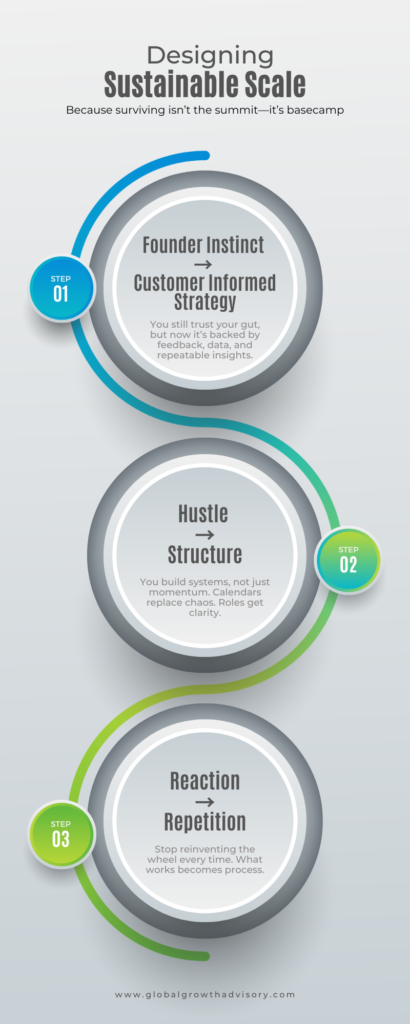There’s a moment in every founder’s journey where the panic starts to fade—but the exhaustion doesn’t. You’ve built something real. Customers are buying. The team’s growing. You’ve survived the Death Zone.
But now you’re asking: “Can we actually scale this thing?” Because surviving isn’t the summit—it’s basecamp.
This week, we’re shifting gears. Over the last few months, the GGA Book Club has focused on how to survive the chaos of the Death Zone. But now, we’re heading into the next phase: how to build sustainable altitude. Not just staying alive—but building something that lasts.
Survival Is Just the Beginning
Early-stage growth often rewards speed and adaptability. But those same traits can become liabilities when you try to scale. The processes are messy. Communication starts to break. Burnout creeps in. What worked when you were scrappy doesn’t work when the stakes rise.
This is where founders and leaders need to shift:
- From founder instinct → to customer-informed strategy. You still trust your gut—but now it’s backed by feedback, data, and repeatable insights.
- From hustle → to structure. You build systems, not just momentum. Calendars replace chaos. Roles get clarity.
- From reaction → to repetition. You stop reinventing the wheel every time. What works becomes process.
Sustainable scale is about design—not just momentum.

What It Takes to Build Altitude
We’ve touched on this before through some of the most influential business books out there.
- In Built to Last, we explored how visionary companies are grounded in values, driven by bold goals (BHAGs), and relentlessly committed to self-improvement. Survival alone doesn’t build legacy—discipline and clarity do.
- And in The Toyota Way, we broke down lean innovation, operational excellence, and culture as a competitive advantage—vital for businesses looking to scale without losing agility.
Those lessons matter even more once you’ve cleared the first few milestones and want to keep climbing. If you’re not designing for scale, you’re designing for stall.

Rewinding to the Spark: The $100 Startup
Before we go any further, I want to take a quick step back.
Because next week’s upcoming book review is personal. The $100 Startup wasn’t just a read—it was a catalyst. It planted the seed for what eventually became Gear Valet.
At the time, I was deep in the chaos—juggling work, three kids in hockey, coaching, and playing myself. The gear was relentless, the smell was worse, and the time to actually clean anything properly just didn’t exist.
Reading that book gave me two things:
- Permission to solve a problem that felt small but wasn’t.
- A reminder that businesses don’t need big budgets to make a big difference.
It was the spark. The validation. The start.
What’s Coming Next
This week, we begin the transition from Death Zone survival to altitude-building strategy.
- Next week, we’ll dive into The $100 Startup—a story about lean launches, solving real problems, and taking action without overthinking it.
- Soon after, I’ll be sharing the first Gear Valet Case Study, walking through how these ideas translated into action—and what we’re learning as we scale it.
This next chapter of the Book Club series will still explore innovation and growth—but from the lens of sustainability, repeatability, and real-world application.
Where are you right now?
Are you still fighting to survive? Starting to scale? Or finally gaining altitude?
Let’s talk about it. The climb never stops—but the view gets better with every step.
#GGABookClub #DeathZone #StartupScale #SustainableGrowth #The100Startup #GearValet #BuilttoLast #TheToyotaWay #GTMStrategy #FounderJourney #BookReview
